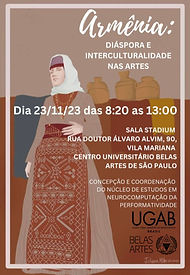
Gustavo Sol

Neurocomputing of Performativity Research Group
Neurocomputing of Performativity Research Group
Led by Gustavo Sol, the research group is based at Belas Artes/SP. Investigates relationships between human-machine interaction interfaces based on artificial intelligence and biophysiological sensing, in order to understand and systematize creative processes in the field of performativity neurocomputation.
The iState system is based on low-cost electronics, captures different physiological dimensions (EEG, ECG, GSR and EMG) has an interface in Max msp and makes use of artificial intelligence. iState is used in the creation of the performance Marash, with Rafaella Gasparian.
Marash is an autobriographic and performative project that tells the story of his family, who came to Brazil fleeing the Armenian genocide in the 20th century. Since 2022, the performance has been discussed at scientific and artistic events in Brazil and abroad, such as IPPT Tallin (Estonia) and IFTR (USA).
Sol presented iState at the Univ. of Toronto, at the DDL_2 Digital Dramaturgy Lab in May 23.
In Nov. the Research Group organized its 1st International Colloquium: Armenia: diaspora and interculturality in the arts.
Belas Artes e CNPq
Iº Colóquio Internacional do Grupo de Pesquisa em Neurocomputação da Performatividade
“Armênia: diáspora e interculturalidade nas artes”
Promovido pelo Grupo de Estudos em Neurocomputação da Performatividade, da Belas Artes, o evento conta com exposições temáticas de especialistas e apresentações artísticas nacionais e internacionais do Brasil, Portugal e da Armênia.
O colóquio aborda o papel das diásporas na formação da sociedade e cultura moderna e contemporânea e, em específico, a diáspora armênica e suas contribuições para às artes. Com formato híbrido, os idiomas do colóquio serão o português (Brasil e Portugal) e o Armênio, com traduções recíprocas.
O evento é coordenado pelos docentes da Belas Artes, Prof. Dr. Gustavo Sol e Prof. Dr. Natalício Batista. O colóquio recebe apoio da União Geral Armênia de Beneficência (UGAB).
Marash - project
FICHA TÉCNICA:
Co-criação e Direção_Gustavo Sol
Co-criação e performance_Rafaella Gasparian
Assistente de Direção e Assistente de Produção: Bruna Ferrari
Cenário e figurino: Sergio Lessa
Vídeos_ Tatiana Boudakian
Consultoria Histórica: Heitor Loureiro e Natalício Batista
Gravação audiovisual_2021_Murilo Dom
Projeto do Grupo de Estudos em Neurocomputação da Performatividade
Centro Universitário Belas Artes, SP.
2023
In the play Marash, the young actress Rafaella Gasparian tells the story of her family that moved to Brazil because of the genocide of the Armenian people, carried out by Turkey in the first half of the 20th century. For those who fled in the diaspora, what remained were unburied bodies and the burden of carrying empty graves, as this historic fact was never politically admitted by Turkey. From 2020, the current situation in Eastern Europe worsens and Armenia goes to war with Azerbaijan in a conflict that has escalated since then. In warning against the risk of a new genocide, the Armenian people around the world are mobilizing in street demonstrations. But Gasparian, living in São Paulo, a city with officially more than 12 million inhabitants and in the midst of a country politically divided by the rise of the far right that promotes the denial of vaccines - therefore, fearing the pandemic, he decides to discuss the diaspora in a different way . Starts an artistic process based on fictional autobiography. As scenic operations, it uses narration and spatialization of memory and fantasy through gestures. Many of them are silent and blank, like their great-grandfather and maternal grandmother, when they tell about their flight through the Syrian desert. Gustavo Sol takes over the direction and contributes to the creation of the structure of the work using an interface developed in his doctorate that classifies neurophysiological states associated with different states of poetic presences through artificial intelligence. Currently, Sol presents a version that, due to the social distance imposed by the pandemic, started to use a webcam to analyze facial expressions associated with heart rate. In terms of Gasparian and Sol's training and project, it consists, in part, of using the interface during rehearsals to identify and help understand the states of performativity, especially the interpreter's possible emotional involvements in terms of what she counts and does on stage. In addition, biofeedback systems as Sol has been researching and using on stage for over 10 years, allow for fluid, live interaction with audiovisual materials. In the case of Gasparian, the process foresees using videos and sounds collected during his recent trip to Armenia, in his family's region of origin. The proposal they bring to IPPT TALLIN 2022 consists of the online presentation and discussion of one of Marash's scenes as a demonstration of the ongoing process, in which the human-machine interaction helps access memory on stage through biofeedback.



